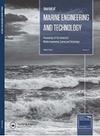DTMB4119船用螺旋桨在不同推进系数下的水声噪声分析
IF 4.4
4区 工程技术
Q1 Engineering
Journal of Marine Engineering and Technology
Pub Date : 2023-07-14
DOI:10.1080/20464177.2023.2233274
引用次数: 0
摘要
研究船用螺旋桨的水声特性和噪声是非常重要的,特别是在水下船舶和潜艇中。本文采用基于有限体积法的计算流体力学方法,对某基准船用螺旋桨在开放水域条件下的水动力噪声进行了数值模拟。数值模拟中采用了DES湍流模型,该模型具有LES模型和RANS模型的优点,是模拟壁面附近小涡流的良好模型。为了提高数值解的精度,在叶片尖端、轮毂和凸台上使用了更细的网格。根据调查,时间步长无关发生在0.001 s。下面,提取DTMB4119螺旋桨在推进系数为0.5 ~ 1.1,距离螺旋桨轴向和垂直于流体流动的1D ~ 10D范围内的水动力噪声的数值分析。从得到的结果来看,流动方向的最高噪声发射电平与低频有关,并且随着频率的增加和距离噪声源的距离的增加,发射的噪声电平降低。从1D到10D增加与噪声源的距离可使发射噪声降低40 dB。推进系数每降低0.1,轴向噪声发射水平就增加10 dB。本文章由计算机程序翻译,如有差异,请以英文原文为准。
Hydro-acoustic and noise analysis of DTMB4119 marine propeller at different advance coefficients using DES turbulence model
Investigating the Hydro-acoustic behaviour and noise of marine propellers is very important, especially in underwater vessels and submarines. The present study aims to numerically model the hydrodynamic noise of a benchmark marine propeller using the computational fluid dynamics method based on the finite volume method under open water conditions. The DES turbulence model is used in the numerical simulation, which is a good model for modelling small eddies near the wall and covers the advantages of both LES and RANS models. To increase the accuracy of the numerical solution, a finer grid has been used on the blades tips, hub, and boss. According to the investigations, time step independence occurs for 0.001 s. In the following, the numerical analysis of the hydrodynamic noise of the DTMB4119 propeller has been extracted at the advance coefficients of 0.5–1.1 and distances of 1D to 10D from the propeller in the axial directions and perpendicular to the fluid flow. Based on the obtained results, the highest level of noise emission in the flow direction is related to low frequencies, and with the increase in frequency and distance from the noise source, the emitted noise level decreases. Increasing the distance from the noise source from 1D to 10D decreases the emitted noise level by 40 dB. For every 0.1 reduction in the advance coefficient, 10 dB is added to the noise emission level in the axial direction.
求助全文
通过发布文献求助,成功后即可免费获取论文全文。
去求助
来源期刊

Journal of Marine Engineering and Technology
工程技术-工程:海洋
CiteScore
5.20
自引率
0.00%
发文量
0
审稿时长
>12 weeks
期刊介绍:
The Journal of Marine Engineering and Technology will publish papers concerned with scientific and theoretical research applied to all aspects of marine engineering and technology in addition to issues associated with the application of technology in the marine environment. The areas of interest will include:
• Fuel technology and Combustion
• Power and Propulsion Systems
• Noise and vibration
• Offshore and Underwater Technology
• Computing, IT and communication
• Pumping and Pipeline Engineering
• Safety and Environmental Assessment
• Electrical and Electronic Systems and Machines
• Vessel Manoeuvring and Stabilisation
• Tribology and Power Transmission
• Dynamic modelling, System Simulation and Control
• Heat Transfer, Energy Conversion and Use
• Renewable Energy and Sustainability
• Materials and Corrosion
• Heat Engine Development
• Green Shipping
• Hydrography
• Subsea Operations
• Cargo Handling and Containment
• Pollution Reduction
• Navigation
• Vessel Management
• Decommissioning
• Salvage Procedures
• Legislation
• Ship and floating structure design
• Robotics Salvage Procedures
• Structural Integrity Cargo Handling and Containment
• Marine resource and acquisition
• Risk Analysis Robotics
• Maintenance and Inspection Planning Vessel Management
• Marine security
• Risk Analysis
• Legislation
• Underwater Vehicles
• Plant and Equipment
• Structural Integrity
• Installation and Repair
• Plant and Equipment
• Maintenance and Inspection Planning.
 求助内容:
求助内容: 应助结果提醒方式:
应助结果提醒方式:


